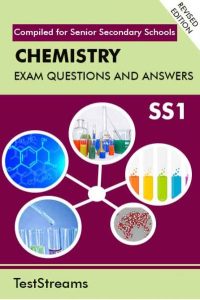Chemistry Exam Questions and Answers for SS2
These Chemistry questions and answers were pulled from our book (Chemistry questions for ss2); Compiled to serve as a reference material to help teachers draw up test and exam questions faster. It could also help students assess their level of exam preparation. Each sample question includes correct answers.
Sample Chemistry Exam Questions and Answers
CHLORINE AND ITS COMPOUNDS
DIRECTION: Choose the correct options from the lettered options.
1. To test for chlorine ______ is used.
A. damp litmus paper and bromine paper
B. damp litmus paper and hydrogen sulphide
C. damp litmus paper and starch-iodide paper
D. none of the above
2. The following are physical properties of chlorine except ______
A. it cannot be liquefied.
B. it is denser than air.
C. it is sparingly soluble in water.
D. it is poisonous.
3. Which of the products of these mixtures is acidic?
A. HCl(g) + chloroform.
B. HCl(g) + water.
C. HCl(g) + Zn.
D. HCl(g) + Mg.
Use the diagram to answer the question.
4. Which of the following gases can be collected by the set-up diagram illustrated?

A. H2.
B. HCl.
C. NH3.
D. N2.
5. Why is a damp blue litmus paper placed at the mouth of a jar during the preparation of hydrogen chloride?
A. To determine the effect of the gas on the litmus paper
B. For the litmus paper to absorb the gas.
C. The litmus paper has no effect in the experiment.
D. To determine when the jar is full.
Click here to get the complete Chemistry questions for ss2
ELECTRODE POTENTIALS. ELECTROCHEMICAL SERIES. ELECTROLYSIS
DIRECTION: Choose the correct options from the lettered options.
1. An electrolyte conducts electricity only when ________
[i] molten.
[ii] in solution.
[iii] solid.
A. [i] only.
B. [ii] only.
C. [i] and [ii] only.
D. [i], [ii] and [iii] only.
2. The law that states, the mass of an element discharged during an electrolysis is directly proportional to the quantity of electricity [Q] passing through it is _______
A. Faraday’s first law of electrolysis.
B. Faraday’s second law of electrolysis.
C. Faraday’s third law of electrolysis.
D. Faraday’s zeroth law of electrolysis.
3. 0.05 Faraday of electricity is passed through acidulated water using platinum electrodes. What volume of each gas is evolved?
A. 0.56 dm3 of H2 and 0.28 dm3 of O2.
B. 1.12 dm3 of H2 and 0.56 dm3 of O2.
C. 0.224 dm3 of H2 and 0.112 dm3 of O2.
D. 2.24 dm3 of H2 and 4.48 dm3 of O2.
4. Zinc easily displaces copper from copper [II] salt solution but lead will not displace copper from copper [II] salt.
Which options best explains the statement?
A. Zinc is placed far below copper in the activity series.
B. Lead is placed far above copper in the activity series.
C. Zinc is placed far above copper in the activity series.
D. Copper is placed far above zinc in the activity series.
5. In an electrochemical cell, reduction always occur ________
A. at the cathode.
B. at the anode.
C. in the electrolyte.
D. none of the above.





